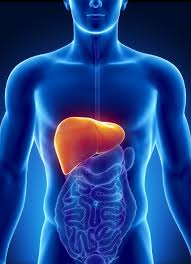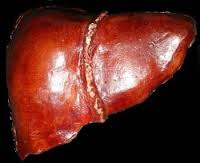QUOTE FOR WEDNESDAY:
The Liver and NAFLD (Non-Alcoholic Fatty Liver Disease).
The liver is a large, meaty organ that sits on the right side of the belly. Weighing about 3 pounds, the liver is reddish-brown in color and feels rubbery to the touch. Normally you can’t feel the liver, because it’s protected by the rib cage.
The liver has two large sections, called the right and the left lobes. The gallbladder sits under the liver, along with parts of the pancreas and intestines. The liver and these organs work together to digest, absorb, and process food.
The liver’s main job is to filter the blood coming from the digestive tract, before passing it to the rest of the body. The liver also detoxifies chemicals and metabolizes drugs. As it does so, the liver secretes bile that ends up back in the intestines. The liver also makes proteins important for blood clotting and other functions.
The liver is a vital organ of vertebrates and in some other animals. In the human it is located in the upper right quadrant of the abdomen, below the diaphragm. The liver has a wide range of functions, including detoxification of various metabolites, protein synthesis, and the production of biochemicals necessary for digestion.
The liver is a gland and plays a major role in metabolism with numerous functions in the human body, including regulation of glycogen storage, decomposition of red blood cells, plasma protein synthesis, hormone production, and detoxification.[3] It is an accessory digestive gland and produces bile, an alkaline compound which aids in digestion via the emulsification of lipids. The gallbladder, a small pouch that sits just under the liver, stores bile produced by the liver. The liver’s highly specialized tissue consisting of mostly hepatocytes regulates a wide variety of high-volume biochemical reactions, including the synthesis and breakdown of small and complex molecules, many of which are necessary for normal vital functions Estimates regarding the organ’s total number of functions vary, but textbooks generally cite it being around 500.
Nonalcoholic fatty liver disease is a term used to describe the accumulation of fat in the liver of people who drink little or no alcohol.
Nonalcoholic fatty liver disease is common and, for most people, causes no signs and symptoms and no complications.
But in some people with nonalcoholic fatty liver disease, the fat that accumulates can cause inflammation and scarring in the liver. This more serious form of nonalcoholic fatty liver disease is sometimes called nonalcoholic steatohepatitis.
At its most severe, nonalcoholic fatty liver disease can progress to liver failure.
Much of the American Liver Foundation’s emphasis during October continues to point to the cause and treatment for liver diseases like hepatitis A, B and C; cirrhosis, biliary atresia and liver cancer.
Much of the Foundation’s emphasis during October continues to point to the cause and treatment for liver diseases like hepatitis A, B and C; cirrhosis, biliary atresia and liver cancer.
But the Foundation is also tapping into the heightened awareness during Liver Awareness Month to draw attention to the alarming increase in the incidence of Non-Alcoholic Fatty Liver Disease (NAFLD), which, staggeringly, affects up to 25 percent of people in the United States.
As its name suggests, NAFLD is the buildup of extra fat in the liver that isn’t caused by alcohol. It’s normal for the liver to contain some fat. But if more than 5 to 10 percent of the liver’s weight is fat, then it is called a “fatty liver.”
Most often, NAFLD tends to develop in people who are overweight or obese or have diabetes, high cholesterol or high triglycerides. Sedentary behavior is another major contributing factor to the onset of NAFLD.
For these reasons, concern continues to grow as one in 10 children—that’s seven million children in the United States—is estimated to have fatty livers.
NALFD can become even more serious. It can progress to Non-Alcoholic Steatohepatitis (NASH), which means that along with the fat, there is inflammation and damage to the liver. A swollen liver may cause scarring (cirrhosis) over time and may even lead to liver cancer or liver failure.
QUOTE FOR TUESDAY:
“One of the best ways to prevent the spread of germs is proper hand hygiene. Make sure those caring for you and your visitors have cleaned their hands. Don’t hesitate to ask any staff member if they’ve cleaned their hands.
Respiratory infections can be easily spread to others. Remember to cover your cough or sneeze and encourage your visitors to do the same.”
MAYO CLINIC
Infection Prevention Month
According to the Centers for Disease Control and Prevention, one out of every 20 hospitalized patients will contract a healthcare-associated infection. The spread of these infections, however, can be controlled. There are several simple and cost-effective strategies that can help prevent infections, from the basic tenet of hand hygiene to the team-oriented approach of Comprehensive Unit-based Safety Programs.
Four infection prevention and process improvement experts weigh-in on the 10 best strategies for prevention of infections.
1. Hand Hygiene. According to the CDC, this is the simplest approach to preventing the spread of infections and needs to be incorporated into the culture of the organization. Surgical team personnel should wash their arms and forearms before a procedure and put on sterile gloves, according to CDC guidelines for infection control. Steven J. Schweon, RN, MPH, infection prevention consultant and member of The Society for Healthcare Epidemiology of America, suggests the “clean in, clean out” approach, wherein hands and equipment are cleaned or disinfected on the way into the patient’s room and on the way out again.
2. Environmental hygiene. According to J. Hudson Garrett, PhD, MSN, MPH, FNP-BC, CSRN, VA-BC, senior director for clinical affairs at PDI, one of the most common sources of transmission of infection is environmental surfaces. Certain types of microbial bacteria are capable of surviving on environmental surfaces for months at a time, according to Mr. Garrett. When healthcare providers or patients touch these surfaces with their skin, the bacteria can be transmitted, causing infection. Thus, it is essential that the environment be kept clean and disinfected. Patients and their families are now the biggest advocates of medical safety, and Mr. Garrett suggests including them in infection prevention protocols, especially with respect to maintaining a clean and sanitary environment. It is also important to involve multidisciplinary environmental hygiene teams in meetings regarding adherence to infection prevention protocols. Irena L. Kenneley, PhD, APRN-BC, assistant professor at the Frances Payne Bolton School of Nursing at Case Western Reserve University in Cleveland and member of the Association for Professionals in Infection Control and Prevention, says that meeting with environmental services and sharing in-house surveillance data helps them relate housekeeping tasks with the spread of infection and helps ensure optimal environmental hygiene.
3. Screening and cohorting patients. Part of the preoperative health evaluation process should include consistent screening of patients, says Siew Lee Grand-Clément, a black belt in robust process improvement at the Joint Commission Center for Transforming Healthcare. These patients must then be treated prior to surgery or any other procedure. However, it is essential that patients who are suffering from the same disease or infection should be kept together in a designated area. “This is essential to ensure that cross infections do not happen,” says Dr. Kenneley. Infections can spread easily from one patient to another if they are being treated in the same area, with the same staff and shared patient care equipment. Some infectious agents are even airborne, says the CDC. Organizations must also evaluate whether the staff is adhering to specific protocols for specific infections, Dr. Kenneley says.
4. Vaccinations. The staff at a healthcare organization may sometimes be the cause of the spread of infections. They come into contact with patients with different types of diseases and may contract infections, according to the CDC. As a result, organizations must make sure that recommended vaccinations are being administered to their staff as recommended. “Keeping healthcare professionals healthy pays dividends,” says Mr. Schweon. It results in decreased transmission risk to co-workers and patients.
5. Surveillance. Through surveillance, organizations should gather data regarding infection patterns at their facility. They should also regularly assess current infection prevention protocols. Having a robust infection surveillance program helps organizations measure outcomes, assess processes of care and promote patient safety, says Mr. Schweon. Sharing the data that the infection surveillance program gathers is the next step. “Communicate, display and discuss all process and outcomes measures with all stakeholders,” says Dr. Kenneley.
6. Antibiotic stewardship. The misuse and overuse of antibiotics can put patients at a risk of contracting infections, according to the Association for Professionals in Infection Control and Epidemiology. Inappropriate antibiotic use may also result in patients becoming resistant to some drugs. If those patients contract an infection, it becomes harder to treat them and the risk of it spreading increases. Mr. Schweon suggests establishing a program to assist with appropriate antibiotic selection and dosing. This helps optimize patient outcomes and minimize adverse events like C. difficile infection and antibiotic toxicity, he says.
7. Care coordination. Breakdown of communication in the surgical preparation, planning and postoperative care management among various care providers during the care transition process can lead to surgical site infections that could otherwise be avoided, says Ms. Grand-Clément. Often, the concept of “stopping the line” is not practiced, which is when care providers are doubtful if certain necessary infection prevention or surgical preparation activities have been completed by the previous care providers, and they halt the care transition process until the matter is resolved. Organizations must avoid situations where a certain process is overlooked by a department that assumes another department has already completed that it. “Activities must be timed and accountability should be specifically assigned,” she says. There needs to be coordination of care and communication within the surgical team as well. There is a risk of breaking the sterile field in the surgery room particularly around the portion of the surgical procedure when multiple, critical activities are taking place at the same time that require staff to multitask, she says. Care coordination goes a long way in preventing surgical site infections.
8. Following the evidence. Keeping abreast of the latest findings regarding the spread of infections and strategies for prevention is essential for a successful infection prevention program. “Infection preventionists must continually monitor the professional literature and attend educational conferences for the latest information with preventing infections,” says Mr. Schweon. However, it is also important to first look at the reality of your organization’s processes and perform your own gap assessment before adopting new practices. What is new in the infection prevention field may not necessarily be the best fit for your organization, says Ms. Grand-Clément.
9. Appreciating all the departments that support the infection prevention program. An organization’s culture may need to shift from thinking that only infection preventionists are accountable for infection prevention, because every patient encounter throughout the care continuum presents all healthcare workers with an infection prevention opportunity, says Ms. Grand-Clément. All caregivers are accountable, and to encourage infection prevention protocols, healthcare professionals should show appreciation for all the people who help keep infections at bay, from the people who prepare surgical instruments for the operating room to those preparing the food safely for patients, staff and visitors, says Mr. Schweon.
10. Comprehensive Unit-based Safety Programs. The Comprehensive Unit-based Safety Program is a structured strategic framework for patient safety improvement that integrates communication, teamwork and leadership, according to the Agency for Healthcare Research and Quality. Each unit should have its own infection prevention champions, with these individuals becoming an extension of the infection prevention and control department, adds Mr. Garrett. “The CUSP program has demonstrated time and time again how effective unit-based champions can be in influencing positive change and improving outcomes,” says Mr. Garrett.
Each of these strategies helps organizations keep the spread of infections at bay. When implemented, supported and carried out together, these 10 strategies are instrumental in ensuring the success of an infection prevention program at an organization.
QUOTE FOR MONDAY:
““Always hold fast to the present. Every situation, indeed every moment, is of infinite value, for it is the representative of a whole eternity.”
Johann Wolfgang von Goethe
QUOTE FOR THE WEEKEND:
“Every woman wants to know what she can do to lower her risk of breast cancer. Some of the factors associated with breast cancer — being a woman, your age, and your genetics, for example — can’t be changed. Other factors — being overweight, lack of exercise, smoking cigarettes, and eating unhealthy food — can be changed by making choices. By choosing the healthiest lifestyle options possible, you can empower yourself and make sure your breast cancer risk is as low as possible.”
BreastCancer.org
QUOTE FOR FRIDAY:
“Studies have shown that your risk for breast cancer is due to a combination of factors. The main factors that influence your risk include being a woman and getting older. Most breast cancers are found in women who are 50 years old or older.”
Centers for Disease Control (CDC)
QUOTE FOR THURSDAY:
“Whether your cancer is invasive or noninvasive helps your doctor determine whether your cancer may have spread beyond your breast, which treatments are more appropriate for you, and your risk of developing cancer in the same breast or your other breast.”
MAYO CLINIC
QUOTE FOR WEDNESDAY:
“Breast cancers can start from different parts of the breast.
Most breast cancers begin in the ducts that carry milk to the nipple (ductal cancers). Some start in the glands that make breast milk (lobular cancers). There are also other types of breast cancer that are less common like phyllodes tumor and angio-sarcoma. A small number of cancers start in other tissues in the breast. These cancers are called sarcomas and lymphomas and are not really thought of as breast cancers. Breast cancer can spread when the cancer cells get into the blood or lymph system and are carried to other parts of the body.”
American Cancer Society



